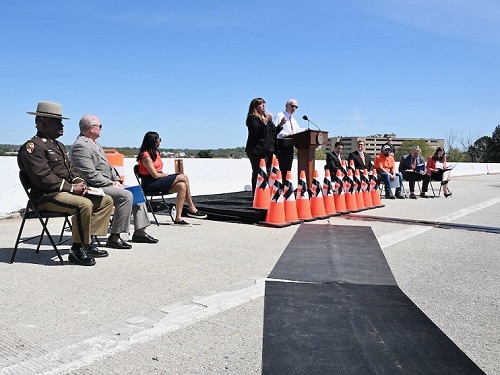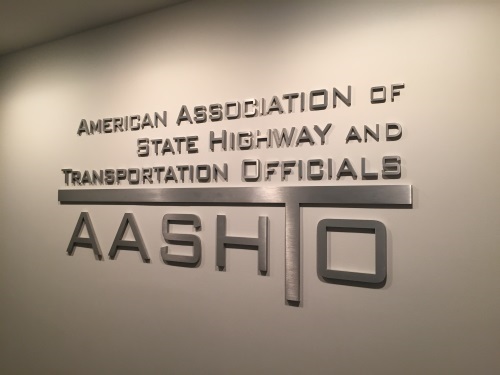Across the country, state departments of transportation held a variety of events in support of the 2024 National Work Zone Awareness Week or NWZAW safety campaign, held April 15-19.
[Above photo by the Maryland Lt. Governor’s Office]
The annual NWZAW campaign acknowledges the dedication of roadway workers and focuses on the message that drivers must slow down, move over whenever possible and pay close attention in highway work zones.

In Maryland, Lieutenant Governor Aruna Miller (D) joined the Maryland Department of Transportation, Maryland State Police, highway workers, and other transportation professionals at the 2024 NWZAW kickoff event on April 16 – an event held above the I-695/I-70 interchange in Baltimore County, overlooking the work zone where six highway workers were killed in a March 2023 crash.
“Being at this location just a little more than a year after the tragedy and seeing where it happened is chilling,” said Lt. Gov. Miller in a statement. “Our efforts will help to change driver behavior and improve work zone safety, but we must continue the conversation and enlist all drivers to join us in making work zones safe.”
After the event, vehicles from regional transportation partners participated in a “Unity Ride” around the west side of I-695, passing by the March 2023 crash site.
“Almost every day we see crashes or near misses in our highway work zones,” noted Maryland DOT Secretary Paul Wiedefeld.

“Our goal is to build and maintain a safe, efficient and equitable transportation system that serves all users,” he noted. “To do that, we must work together to provide our dedicated highway professionals with the attention – and protection – they deserve.”
“We count on construction workers to keep our roads safe – and they count on all of us to keep them safe on the job,” said Polly Trottenberg, deputy secretary for the U.S. Department of Transportation, in a separate statement.
“In 2022, almost 900 people tragically lost their lives in work zone crashes. So this National Work Zone Awareness Week, we call on all drivers to slow down and pay attention. Our nation’s roadway workers are counting on you,” she added.
Crashes in highway work zones happen most frequently when drivers are speeding or aren’t paying attention to changing road conditions, according to the Federal Highway Administration.
In 2022, speed was a factor in 34 percent of fatal work zone crashes according to data tracked by the National Work Zone Safety Information Clearinghouse; a system operated by the American Road and Transportation Builders Association and the Texas A&M Transportation Institute in coordination with the Federal Highway Administration.
“The men and women fixing our streets, highways and bridges are among the most vulnerable road users because their jobs require them to be on foot near oncoming traffic,” said FHWA Administrator Shailen Bhatt. “We hope drivers stay alert so these mothers, fathers, sons and daughters who are America’s transportation heroes can do their jobs without incident and arrive home safely when their shift is over.”
“Our roads are not speedways,” stressed Garrett Eucalitto, commissioner of the Connecticut Department of Transportation, in a statement. “Our crews are in harm’s way all the time, but they shouldn’t have to put their lives on the line to keep roads and highways safe.”
Eucalitto – who also serves as the vice president of American Association of State Highway and Transportation Officials – pointed out that in 2023 alone, motorists crashed into 141 of his agency’s trucks. “We need drivers to slow down and pay attention—understanding their actions can have lasting impacts on families and communities,” he said.
Patrick McKenna – director of the Missouri Department of Transportation, chair of the AASHTO Committee on Safety, and a former AASHTO president – stressed that, with the 2024 construction season set to begin nationwide, the safety of transportation workers will be paramount for every state DOT.
“Your decisions as a driver can make the difference between arriving safely or having deadly consequences,” he noted in a statement. “Any time you pass workers on the roadway, remember that buckling up, leaving your phone at your side, slowing down and staying alert are the key behaviors to get everyone home safe every day.”
Besides work zones for construction, McKenna said highway crews are out daily mowing, patching potholes, picking up roadside debris and fixing signals, lights and guardrail. “It’s not just a courtesy to slow down and move over for these work zones – it’s the law,” he noted. “Missouri’s ‘Move Over’ law requires drivers to change lanes, if safe to do so, when approaching MoDOT vehicles, law enforcement vehicles and any other emergency vehicle with lights flashing. If drivers can’t change lanes safely, they must slow down as they pass the emergency vehicles. Drivers should be aware of changing traffic conditions, observe warning signs and merge before reaching lane closures.”
Other state DOT events conducted in support of the 2024 NWZAW campaign, including:
- Governor Tony Evers (D) and Wisconsin Department of Transportation Deputy Secretary Kristina Boardman joined county and local officials at a press conference to urge people to drive safely in work zones statewide for the 2024 construction season. The agency noted that, each year, more than 2,100 crashes happen in Wisconsin work zones, putting workers and motorists’ lives at risk.
- The Mississippi Department of Transportation hosted a ceremony on April 16 at the Fallen Workers Memorial to honor the 49 agency workers listed on the monument. “Each loss we have endured together is a tragic reminder of the dangers of working along highways. Today, we honor these brave souls who lost their lives while serving on the frontlines of our highways by renewing our commitment to work zone safety,” said Jeff Ely, the agency’s chief of staff, in a statement. “Let’s not only remember their sacrifices, but also reflect on the importance of their work. Every orange cone, every flashing light, every road sign they placed was a testament to their commitment to keeping us safe.”
- The Kansas Department of Transportation produced a four-part video series to highlight the dangers roadway works face when working in highway work zones.
- The New Mexico Department of Transportation unveiled a new “mascot” to help educate the public regarding work zone safety: “Zippy” the roadrunner. As part of the launch of the Zippy campaign, NMDOT staff created “roadrunners” out of orange construction zone barrels as an added tool to help raise awareness about work zone safety across the state. “Work zone safety is a priority and the launch of our own safety mascot, Zippy, is just one of a variety of tools we’re using to raise awareness about the importance of safe driving practices in work zones,” noted NMDOT Secretary Ricky Serna in a statement.
 Top Stories
Top Stories


